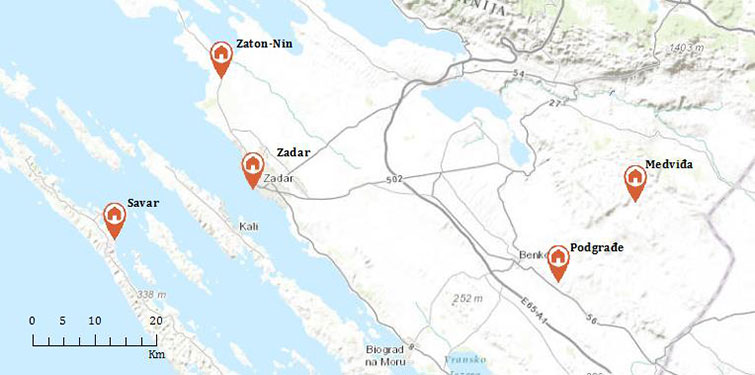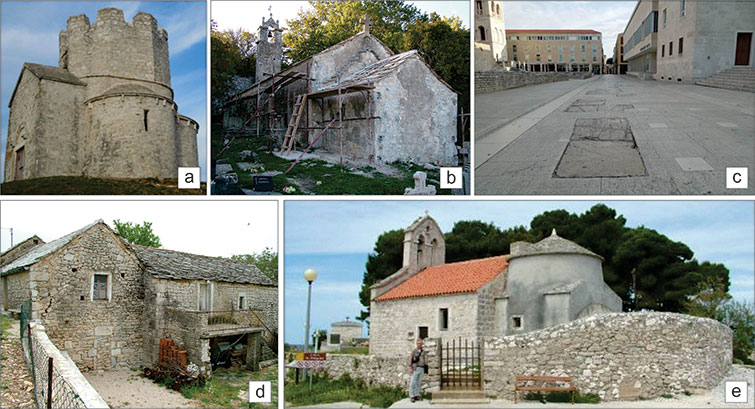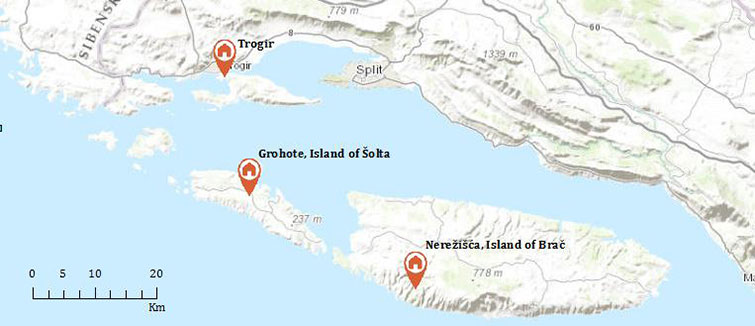Platy limestone – geologic definition and its use as a mineral commodity
Jernej Jež, Uroš Barudžija, Sara Biolchi, Stefano Devoto, Goran Glamuzina, Tvrtko Korbar
In Zadar County, two objects are situated in the coastal mainland area (Nin surroundings and Zadar old town), two objects in the Ravni kotari area in the hinterland (Medviđa and Podgrađe villages), and one object is situated on the island of Dugi otok (Savar village) (Figs. 2.6 and 2.7).


Platy limestone elements used on the roofs of the mainland objects mostly originate from Benkovac PL, which is a major regional source of platy limestone, commonly used as original and replacement material. Platy elements on the roof of Savar (Dugi otok) originate from a minor local source. Some of the street plates in Zadar, especially those protected as historical sites, originate from the Cenomanian Milna formation cropping out on the island of Lavdara. However, these blocky “plates” have been produced by cutting. Yet, some rare PL horizons on Lavdara are characterized by plates of huge dimensions.
Building blocks for walls and other non-standardized elements on all four rural objects are mostly strictly local, from the place or close vicinity of the objects.
Manufactured elements characterized by standardized dimensions mostly originate from some of the major and historical quarries in massive grainy limestone outcropping in Dalmatia. The most probable quarries in the area of Zadar County are those located in the central part of the island of Dugi otok (Borišina-Ovča). However, some more recent replacements are mostly from the major quarries on the island of Brač (Pučišća unit). All original manufactured elements are characterized by coarse-finishing produced by hand-tools, while the replacements are characterized by fine-finishing produced by machines. All historical (the oldest) blocks used for Zadar's downtown streets originate from Lavdara island (brownish to reddish limestone), which is obviously recognized as a major place for a simple excavation of these semi-manufactured elements because of the subhorizontal bedding and the accessibility to these coastal outcrops by boats. However, most of the replacements in the streets of Zadar also originate from major historical quarries located on the island of Brač (Pučišća and Dol formations from quarries located in Pučišća and Škrip).
In Split-Dalmatia County one object is situated in the centre of the coastal (mainland) town of Trogir (Trogir cathedral), one object is on the island of Brač (Blaca monastery), and one object is on the island of Šolta (Grohote village), in the wider Split region (Figs. 2.8 and 2.9).


Platy limestone used for the Trogir cathedral apses roofs is probably a replacement with Benkovac PL. There is a question of the possible local origin of the original plates, since there is a lot of platy limestone material outcropping in the wider Trogir area. The PL used for roofs in the Blaca monastery and in “Ruića dvori” originates from local PL units recognized in this study.
Building blocks for walls and other non-standardized elements of residential houses “Ruića dvori” in Grohote are strictly local, from the place or close vicinity of the object. Building blocks found in the Blaca hermitic monastery represent an exceptional geological example of the usage of a local source of limestone for building such a major architectural complex. In the basement and the background of the complex, there are natural outcrops of subhorizontal limestone beds (Gornji Humac Fm). The constructors used bedding discontinuities and a nearly perpendicular joint system to excavate and use the building blocks for basic elements (walls, streets, frames...). Furthermore, they used natural limestone beds for the construction of some unique in-situ facilities (basement for olive/grape pressure system).
Manufactured elements including building blocks for the Trogir cathedral apses are of local and regional origin, considering the fact that there are at least two major and historical quarries (Seget and Čiovo-Okrug) in the massive greyish-white grainy limestone of the Seget Formation outcropping in the Trogir region. However, many blocks and sculptures also originate from some of the major and historical quarries located on the island of Brač (Pučišća and Škrip). Manufactured elements characterized by standardized dimensions (e.g. window frames and door posts) used in Blaca and Grohote also originate from some of the major quarries in the massive grainy limestone of the Pučišća formation, possibly from quarries located in Pučišća and Škrip on the island of Brač. Considering the location of Blaca, it is also possible that some of the manufactured elements originate from similar material outcropping in the village of Nerežišće (Dračevica quarry).
In the Dubrovnik-Neretva County two objects are situated on the island of Korčula (Vela Luka and Žrnovo-Podstrana), while one object is on the Pelješac peninsula (Nakovana) (Figs. 2.10 and 2.11). Platy limestone elements and Building blocks for all three objects originate mostly from a local source of PL (see Appendix 2.3).


Manufactured elements characterized by standardized dimensions (e.g. window frames and door posts) used in Nakovana originate from Korčula limestone, while the elements used for the Žrnovo object originate from strictly local PL quarries. They were carved from intercalated thick-bedded bioclastic limestone by skilled professional stonemasons or “stone-artists”. There are small stone-cutters still active in the area of Žrnovo and Korčula.










